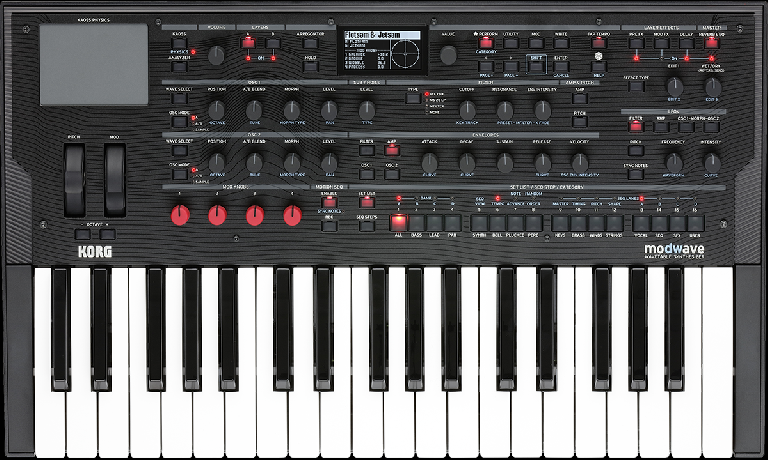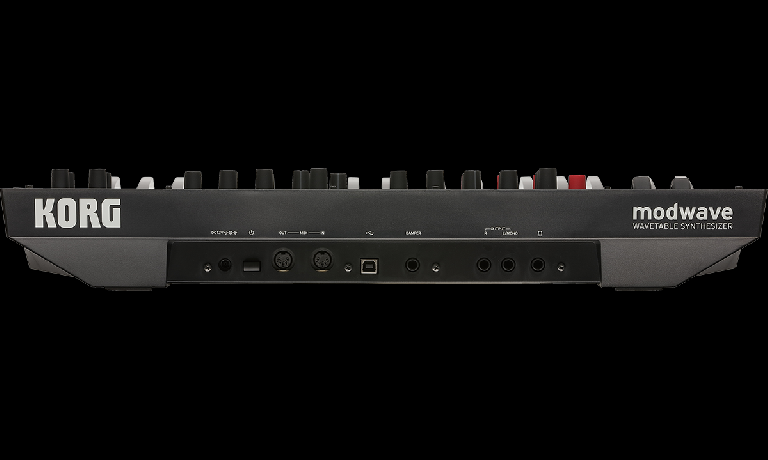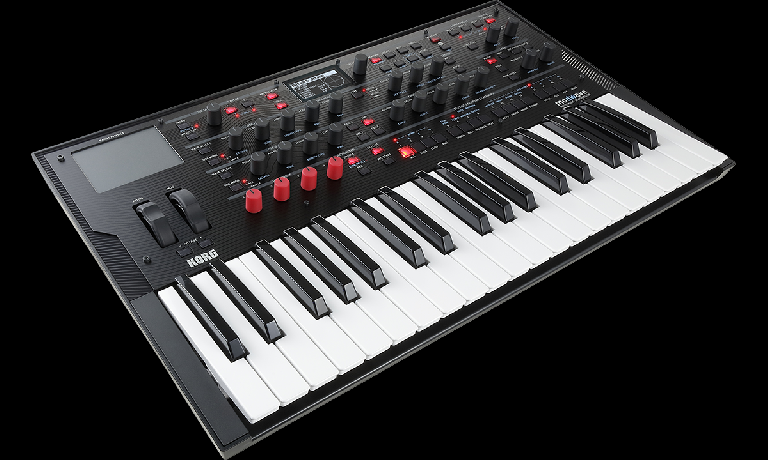In 1985, Korg’s DW-8000 combined digital wavetables with rich analog filters to give users sounds which were impossible to create with analog oscillators. It’s still a cult favorite today.
modwave builds on the DW legacy and transforms it into a modern monster synth, featuring incredibly deep wavetable oscillators, gorgeous filters, wildly flexible modulation, unmatched polyphony, comprehensive pattern sequencing, and immediately satisfying hands-on control to deliver unique, powerful, and easily customizable sounds and phrases.
modwave also introduces two unique new tools for creating dynamic motion: Kaoss Physics and Motion Sequencing 2.0. Kaoss Physics combines an x/y Kaoss pad with modulatable game physics to create a responsive, interactive controller that is—besides being powerful— a lot of fun to explore. Motion Sequencing 2.0 brings the organic, continuously evolving patterns of the wavestate’s Wave Sequencing 2.0 into the world of motion sequencing, including multiple lanes and real-time recording to help you create complex and evolving phrases that other step sequeners cannot.
Like Wave Sequencing 2.0 (wavestate) and altered FM (opsix), modwave’s evolved wavetable synthesis delivers its own brand of completely unique sounds and a knob-per-function layout that makes customizing those sounds fast and easy. To start, there are hundreds of preset sounds empowered by this new architecture, organized by front-panel category buttons, and all instantly customizable via the four Modulation Knobs. modwave’s distinctive wavetable timbres start with aggressive basses & leads, and lush ambient pads which will add a new dimension to your tracks.
But that is just the start. Those who want to dig deeper will find an endless source of discovery; you’ll be finding new things in this synth for a long, long time because of the unique synth architecture. Once you have started finding new sounds – save as many as you like; there’s room for thousands more.
It features over 200 wavetables, each containing up to 64 waveforms—from thousands of individual waves. You can use the 30+ Modifiers to change their basic character, and the 13 Morph Types to process them in real-time. Create new hybrids from any two wavetables using the realtime A/B Blend, giving you over 230 million wavetable variations out of the box. But you can also load your own custom wavetables in Serum or WaveEdit formats.
Each Program has two full-featured wavetable oscillators, plus a sub oscillator/noise generator and any of a dozen stereo filter types, including the aggressive MS-20, sweet Polysix, and the newly enhanced Multi Filter. You can animate almost any parameter, using the flexible modulation system, with four triggerable envelopes, five LFOs, dual mod processors and two key-track generators–plus multi-lane Motion Sequencing and Kaoss Physics.
Even with all that synthesis power, playing up to four simultaneous wavetables per voice in a single Program, the modwave still offers 32-voice polyphony.
Kaoss Physics
Kaoss Physics models a ball rolling on a surface and/or bouncing off walls. You can start the ball by flicking a finger on the x/y pad, or launch the ball automatically using a trigger source such as Gate + Damper. You can also directly control the ball by holding your finger on the pad.
The position of the ball produces four modulation signals, which can be used to control any modulation destination you like: the X and Y locations, the distance from the center, and the angle relative to the X axis.
There is a bump in the virtual surface, going either down or up, like a valley or a hill. You can set the height or depth of the bump, and choose one of several different shapes for its slopes. The surface has adjustable friction, so that the ball slows down as it travels. There are walls on the four sides of the surface, and when the ball hits a wall, it bounces off. Walls can slow down the ball, as if they were padded, or accelerate the ball, like bumpers in a pinball machine. The walls can also be removed entirely, so that the surface wraps around to the opposite edges like a vintage arcade game.
The modeled environment can create specific modulation effects. For instance, use a centered bump with negative height so that the modulation values always eventually return to 0. Or, position a bump with positive height on a side or a corner, to push modulation values away from that zone
Most parameters, including Tilt, Friction, Time, Bump Height and Position, etc. are modulatable. You can even modulate them from the Kaoss Physics outputs—for instance, try modulating Tilt X with Kaoss Y.
The result is an interactive controller that amplifies your physical gestures, transforming them into complex musical results.
Motion Sequencing 2.0
Motion Sequencing 2.0 is evolved from the wavestate’s Wave Sequencing 2.0. Timing, Pitch, Shape, and four sets of Step Sequence values are separated into “Lanes,” each with their own loop start and loop end, adding a deeper, more customizable level of phrase and modulation recording.
Every time the sequence moves forward, the individual Lanes are combined to create the output. For instance, a step sequence value may be matched with a different duration, pitch, and shape every time that it plays. You can modulate each Lane’s loop points separately for every note, using velocity, LFOs, envelopes, Mod Knobs, or other controllers. Each note in a chord can be playing something different!
Lanes can also randomize the step order every time they play. Finally, individual steps can be randomly skipped, with a modulatable probability from 0 to 100%. The result is organic, ever-changing sounds that respond to your control. The dual onboard arpeggiators can interact with Motion Sequences for even more possibilities.
An arsenal of effects
Each Layer has three dedicated effects, plus a send to the Performance’s master reverb, followed by a master parametric EQ. Along with standards such as compressors, EQs, choruses, flangers, phasers, and stereo delays, you’ll find distinctive processors such as the Wave Shaper, Talking Modulator, Reverse Delay, Multiband Mod Delay, and Overb (from the OASYS and Kronos), plus modeled effects including VOX guitar amps, VOX wah, multi-head tape echo, and a collection of classic guitar pedals. Randomization that inspires.
Editor/Librarian software
The modwave Editor/Librarian lets you edit and organize sounds via your macOS or Windows computer (including the latest Apple M1-based systems). Using USB networking for high-speed communication, it works like a second front panel for the instrument, so there’s no need to synchronize or transfer data. Animations show the effects of modulation in real-time – a great help when programming.
Set Lists and Smooth Sound Transitions
Set Lists offer effortless organization of your wavestate Performances, and deliver instant access at the gig or in rehearsal. Smooth Sound Transitions allow previously-played voices and effects to continue to ring out naturally, even once a new sound has been selected.
Connections
Balanced stereo outputs connect to any recording or monitoring system, and a stereo headphone output is provided for private playing or onstage cueing. Din-style MIDI jacks ensure connection to other MIDI-equipped instruments and audio gear, and the modwave supports class-compliant USB MIDI connections to Windows and macOS computers.
Price: TBA





 © 2024 Ask.Audio
A NonLinear Educating Company
© 2024 Ask.Audio
A NonLinear Educating Company
Discussion
Want to join the discussion?
Create an account or login to get started!